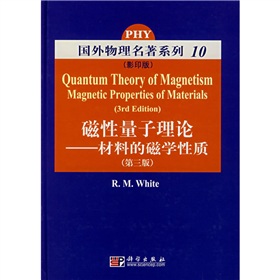国外物理名著系列10`磁性量子理论:材料的磁学性质 》》 电子书下载 PDF下载

内容简介
《磁性量子理论:材料的磁学性质(第3版)(影印版)》从“线性响应”出发研究磁学现象。主要内容是研究磁性材料在磁场作用下是如何响应的(磁场可以是均匀的或不均匀的,静止的或变化的)。《磁性量子理论:材料的磁学性质(第3版)(影印版)》的前两版主要研究了磁性响应,本版中还增加了磁性材料的磁阻抗,同时在每章后还增加了一些习题以帮助读者加深对内容的理解。
《磁性量子理论:材料的磁学性质(第3版)(影印版)》关于磁学基本原理的论述和前两版相比变化不大。随着研究的深入和新应用的发展,新的磁学现象不断涌现,如《磁性量子理论:材料的磁学性质(第3版)(影印版)》第二版出版以来,发现了巨磁阻效应,自旋电子学的研究队伍也在迅速扩大。《磁性量子理论:材料的磁学性质(第3版)(影印版)》不仅介绍了这些新现象,而且详细讨论了新材料(如高温超导材料)的一个重要性质——磁性。我们通过测量磁化率,核磁共振,中子散射等手段来研究材料的磁性,这为新材料的研究提供了便利。
根据最近的研究成果,《磁性量子理论:材料的磁学性质(第3版)(影印版)》对一些资料作了重要的修正,也新加入了一些资料(新加入了有关磁性多层薄膜的一章)。《磁性量子理论:材料的磁学性质(第3版)(影印版)》紧跟学科发展,是一本介绍新材料科学关键性能——磁性的经典著作。
《磁性量子理论:材料的磁学性质(第3版)(影印版)》关于磁学基本原理的论述和前两版相比变化不大。随着研究的深入和新应用的发展,新的磁学现象不断涌现,如《磁性量子理论:材料的磁学性质(第3版)(影印版)》第二版出版以来,发现了巨磁阻效应,自旋电子学的研究队伍也在迅速扩大。《磁性量子理论:材料的磁学性质(第3版)(影印版)》不仅介绍了这些新现象,而且详细讨论了新材料(如高温超导材料)的一个重要性质——磁性。我们通过测量磁化率,核磁共振,中子散射等手段来研究材料的磁性,这为新材料的研究提供了便利。
根据最近的研究成果,《磁性量子理论:材料的磁学性质(第3版)(影印版)》对一些资料作了重要的修正,也新加入了一些资料(新加入了有关磁性多层薄膜的一章)。《磁性量子理论:材料的磁学性质(第3版)(影印版)》紧跟学科发展,是一本介绍新材料科学关键性能——磁性的经典著作。
目录
1 The Magnetic Susceptibility
1.1 The Magnetic Moment
1.2 The Magnetization
1.3 The Generalized Susceptibility
1.3.1 The Kramers-Kronig Relations
1.3.2 The Fluctuation-Dissipation Theorem..
1.3.3 Onsager Relation
1.4 Second Quantization
1.4.1 Example:The Degenerate-Electron Gas
1.4.2 Example:The Zeeman Interaction
2 The Magnetic Hamiltonian
2.1 The Dirac Equation
2.2 Sources of Fields
2.2.1 Uniform External Field
2.2.2 The Electric Quadrupole Field
2.2.3 The Magnetic Dipole(Hyperfine)Field.
2.2.4 Other Electrons on the Same Ion
2.2.5 Crystalline Electric Fields
2.2.6 Dipole-Dipole Interaction
2.2.7 Direct Exchange
2.2.8 Superexchange
2.2.9 Molecular Magnets
2.2.10 Double Exchange
2.2.11 Exchange on a Surface
2.3 The Spin Hamiltonian
2.3.1 Transition-Metal Ions
2.3.2 Rare-Earth Ions
2.3.3 Semiconductors
3 The Static Susceptibility of Noninteracting Systems
3.1 Localized Moments
3.1.1 Diamagnetism
3.1.2 Paramagnetism of Transition-Metal Ions
3.1.3 Paramagnetism of Rare-Earth Ions
3.2 Metals
3.2.1 Landau Diamagnetism
3.2.2 The de Haas-van Alphen Effect
3.2.3 Quantized Hall Conductance
3.2.4 Pauli Paramagnetism
3.3 Measurement of the Susceptibility
3.4 Local Moments in Metals
3.4.1 Virtual Bound States
3.4.2 Andersons Theory of Moment Formation
3.4.3 The Kondo Effect
4 The Static Susceptibility of Interacting Systems:Local Moments
4.1 High Temperatures
4.2 Low Temperatures
4.3 Temperatures Near Tc
4.4 Landau Theory of Second-Order Transitions
4.5 Critical Phenomena
4.5.1 Order in 2D
4.6 Stoner-Wohlfarth Model
4.7 Dynamic Coercivity
4.8 Magnetic Viscosity
5 The Static Susceptibility of Interacting Systems:Metals.
5.1 Fermi Liquid Theory
5.2 Heavy Fermion Systems
5.3 Itinerant Magnetism
5.3.1 The Stoner Model
5.3.2 The Hubbard Model
6 The Dynamic Susceptibility of Weakly Interacting Systems:Local Moments
6.1 Equation of Motion
6.2 The Bloch Equations
6.3 Resonance Line Shape
6.3.1 The Method of Moments
6.3.2 The Relaxation-Function Method
6.3.3 Spin Diffusion
6.4 Spin Echoes
6.4.1 Measurement of T1
6.4.2 Calculation of T1
7 The Dynamic Susceptibility of Weakly Interacting Systems:Metals
7.1 Paramagnons
7.2 Fermi Liquid Theory
7.3 Conduction-Electron Spin Resonance
7.4 Spin Waves
7.5 Local Moments in Metals
7.6 Faraday Effect
8 The Dynamic Susceptibility of Strongly Interacting Systems
8.1 Broken Symmetry
8.2 Insulators
8.2.1 Spin-Wave Theory
8.2.2 Coherent Magnon State
8.2.3 Magnetostatic Modes
8.2.4 Solitons
8.2.5 Thermal Magnon Effects
8.2.6 Nonlinear Processes
8.2.7 Chaos
8.2.8 Optical Processes
8.3 High Temperatures
8.4 Micromagnetics
8.4.1 Magnetic Force Microscope
8.4.2 Phenomenological Damping
8.5 Metals
9 Thin Film Systems
9.1 Interfaces
9.1.1 Exchange Bias
9.1.2 Biquadratic Exchange
9.2 Trilayers
9.2.1 The RKKY Ineraction
9.2.2 Quantum Well Model
9.2.3 Giant Magnetoresistance(GMR)
9.2.4 Tunneling
9.2.5 Spin Transfer
9.2.6 Spin Hall Effect
10 Neutron Scattering
10.1 Neutron Scattering Cross Section
10.2 Nuclear Scattering
10.2.1 Bragg Scattering
10.2.2 Scattering of Phonons
10.3 Magnetic Scattering
10.3.1 Bragg Scattering
10.3.2 Spin Dynamics
10.4 Example:Manganese Oxides
10.5 Example:Quantum Phase Transitions
References
Index
1.1 The Magnetic Moment
1.2 The Magnetization
1.3 The Generalized Susceptibility
1.3.1 The Kramers-Kronig Relations
1.3.2 The Fluctuation-Dissipation Theorem..
1.3.3 Onsager Relation
1.4 Second Quantization
1.4.1 Example:The Degenerate-Electron Gas
1.4.2 Example:The Zeeman Interaction
2 The Magnetic Hamiltonian
2.1 The Dirac Equation
2.2 Sources of Fields
2.2.1 Uniform External Field
2.2.2 The Electric Quadrupole Field
2.2.3 The Magnetic Dipole(Hyperfine)Field.
2.2.4 Other Electrons on the Same Ion
2.2.5 Crystalline Electric Fields
2.2.6 Dipole-Dipole Interaction
2.2.7 Direct Exchange
2.2.8 Superexchange
2.2.9 Molecular Magnets
2.2.10 Double Exchange
2.2.11 Exchange on a Surface
2.3 The Spin Hamiltonian
2.3.1 Transition-Metal Ions
2.3.2 Rare-Earth Ions
2.3.3 Semiconductors
3 The Static Susceptibility of Noninteracting Systems
3.1 Localized Moments
3.1.1 Diamagnetism
3.1.2 Paramagnetism of Transition-Metal Ions
3.1.3 Paramagnetism of Rare-Earth Ions
3.2 Metals
3.2.1 Landau Diamagnetism
3.2.2 The de Haas-van Alphen Effect
3.2.3 Quantized Hall Conductance
3.2.4 Pauli Paramagnetism
3.3 Measurement of the Susceptibility
3.4 Local Moments in Metals
3.4.1 Virtual Bound States
3.4.2 Andersons Theory of Moment Formation
3.4.3 The Kondo Effect
4 The Static Susceptibility of Interacting Systems:Local Moments
4.1 High Temperatures
4.2 Low Temperatures
4.3 Temperatures Near Tc
4.4 Landau Theory of Second-Order Transitions
4.5 Critical Phenomena
4.5.1 Order in 2D
4.6 Stoner-Wohlfarth Model
4.7 Dynamic Coercivity
4.8 Magnetic Viscosity
5 The Static Susceptibility of Interacting Systems:Metals.
5.1 Fermi Liquid Theory
5.2 Heavy Fermion Systems
5.3 Itinerant Magnetism
5.3.1 The Stoner Model
5.3.2 The Hubbard Model
6 The Dynamic Susceptibility of Weakly Interacting Systems:Local Moments
6.1 Equation of Motion
6.2 The Bloch Equations
6.3 Resonance Line Shape
6.3.1 The Method of Moments
6.3.2 The Relaxation-Function Method
6.3.3 Spin Diffusion
6.4 Spin Echoes
6.4.1 Measurement of T1
6.4.2 Calculation of T1
7 The Dynamic Susceptibility of Weakly Interacting Systems:Metals
7.1 Paramagnons
7.2 Fermi Liquid Theory
7.3 Conduction-Electron Spin Resonance
7.4 Spin Waves
7.5 Local Moments in Metals
7.6 Faraday Effect
8 The Dynamic Susceptibility of Strongly Interacting Systems
8.1 Broken Symmetry
8.2 Insulators
8.2.1 Spin-Wave Theory
8.2.2 Coherent Magnon State
8.2.3 Magnetostatic Modes
8.2.4 Solitons
8.2.5 Thermal Magnon Effects
8.2.6 Nonlinear Processes
8.2.7 Chaos
8.2.8 Optical Processes
8.3 High Temperatures
8.4 Micromagnetics
8.4.1 Magnetic Force Microscope
8.4.2 Phenomenological Damping
8.5 Metals
9 Thin Film Systems
9.1 Interfaces
9.1.1 Exchange Bias
9.1.2 Biquadratic Exchange
9.2 Trilayers
9.2.1 The RKKY Ineraction
9.2.2 Quantum Well Model
9.2.3 Giant Magnetoresistance(GMR)
9.2.4 Tunneling
9.2.5 Spin Transfer
9.2.6 Spin Hall Effect
10 Neutron Scattering
10.1 Neutron Scattering Cross Section
10.2 Nuclear Scattering
10.2.1 Bragg Scattering
10.2.2 Scattering of Phonons
10.3 Magnetic Scattering
10.3.1 Bragg Scattering
10.3.2 Spin Dynamics
10.4 Example:Manganese Oxides
10.5 Example:Quantum Phase Transitions
References
Index
同类热门电子书下载更多
- 西方语言学原版影印系列丛书17:英语语言史社会语言学研究
- 大唐狄公案
- Aspen美国法学院教材系列:公司法
- 社会学经典教材影印丛书:社会学理论的结构
- 莎士比亚作品解读丛书·英文影印插图版:第十二夜
- 国际商务精选教材:国际商务基础
- 国外优秀信息科学与技术系列教学用书:程序设计语言概念
- 金融工程和计算: 原理数学算法
- 周易
- 研究生前沿教材书系:复杂性和临界状态
- 阿登版莎士比亚:威尼斯商人
- 莎士比亚作品解读丛书·英文影印插图版:罗密欧与朱丽叶
- 国外语言学与应用语言学人大版影印文库:语言与心智
- 剑桥英语等级考试系列:剑桥第一证书英语考试教程1
- 教育学经典教材:教育管理学
- 海外优秀数学教材系列丛书:概率论与数理统计
- 国外物理名著系列10`磁性量子理论:材料的磁学性质
- 美国著名医学院校教材系列:病史和查体
- Lewin细胞生物学
- 宋诗纪事补订:手稿影印本
Copyright © 2025 by topbester.com.
All Rights Reserved.
沪ICP备14027842号-1
All Rights Reserved.
沪ICP备14027842号-1